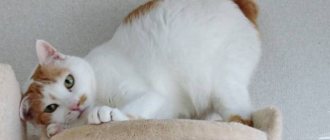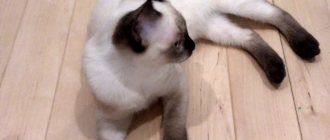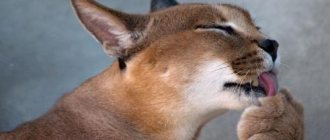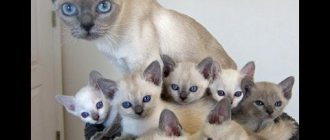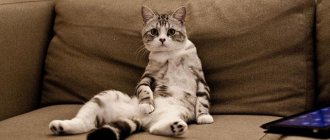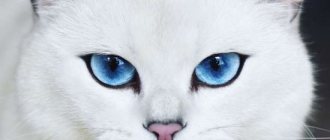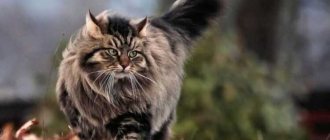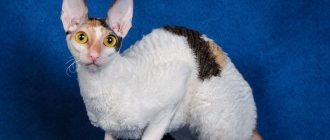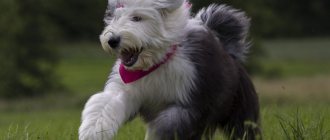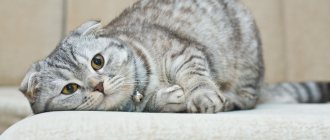The Nibelung cat breed is so young that it is not yet possible to talk about its widespread distribution.
There are not many fans of the breed, but if a Nibelung once appears in the house, then there is no doubt about the correct choice of the pet. History of origin. The breed owes its existence to the American Cora Cobb, who was breeding cats in the 1980s. A kitten with beautiful elongated gray fur came into her house, the result of a cross between a Russian blue cat and a purebred male.
A little later, another litter was obtained from the same pair of cats, from which Cora chose a female kitten with an even slightly longer gray coat.
Nibelung cat breed: description, care, feeding and choice of kitten
The Nibelung cat breed is so young that it is not yet possible to talk about its widespread distribution.
There are not many fans of the breed, but if a Nibelung once appears in the house, then there is no doubt about the correct choice of the pet. History of origin. The breed owes its existence to the American Cora Cobb, who was breeding cats in the 1980s. A kitten with beautiful elongated gray fur came into her house, the result of a cross between a Russian blue cat and a purebred male. A little later, another litter was obtained from the same pair of cats, from which Cora chose a female kitten with an even slightly longer gray coat.
Origin history and interesting facts
The history of the development of the breed originates in Russia. The animals were originally bred to catch rats, and then their decorative qualities were assessed. Official selective breeding of cats with plush fur began in 1893.
A good livestock in Russia was formed in the 80s. Russian shorthair blue cats are usually crossed with cats that are imported from abroad.
Russian Blue cat - breed characteristics
Interesting fact! Thoroughbred representatives are not at all afraid of water. Cats and tomcats are excellent swimmers, which is why they got the name “sea”. Animals do not bypass even small puddles on their way, but walk straight through the water. A Russian blue cat can also easily pull fish out of an aquarium.
General information
Later, Cora Cobb crossed the grown kittens from two matings and got the first Nibelungs. It was not possible to register the standard the first time, but by 1987 the first standard was adopted, and in 1997 the first championship title was received at the exhibition. Today, Nibelung cats are recognized by all major phenological associations.
INTERESTING: the name of the breed literally translates as “child of the mists.” The origin of the reference to Wagner's opera was the names of the parents of the first kittens of the breed, taken from the work.
There is also a breed in Russia, although it was obtained as a result of a genetic mutation among the Russian Blue breed. The most titled Nibelung in Russia is identified as a representative of the breed at American exhibitions, bears the nickname Osoka and has the most awards within the breed.
External description
The Nibelung cat breed is very similar to its ancestor, the Russian Blue cat breed.
The requirements of the TICA standard are very similar, but there are still some nuances. The Nibelungs have a wedge-shaped, medium head. The outline of the skull gives 7 flat edges on the muzzle. The slender neck is elongated, but the proportions of the harmonious structure are maintained. Medium-sized almond-shaped eyes. The iris in adulthood is green and emerald, but in kittens it is often the color of topaz at birth. By the end of adulthood, the iris should become green.
The ears have a slight tilt forward and are set wide apart. The ear cartilage is translucent, the tip of the ear is rounded, and the tassel is missing. The nose is long, straight, and forms a vertical line with the chin line. The chin is pronounced, and in males it is heavier.
The breed's cheeks are not visible; they fit compactly into the wedge of the head. But the whisker pads are clearly outlined. The bite is only correct, distortions are not allowed.
The body and the entire body are inherited from the Russian Blue, so the Nibelungs are slender, graceful cats with a straight back. The legs are slightly elongated, and there are pants on the hind legs. The feet have oval, elongated pads, and there is down between the toes. The breed has a long tail, equal to the length of the body. A notable feature is that the hair on the tail is longest and thinnest.
Cats have medium-long fur all over their bodies, their panties and mane are poorly defined, but in cats, their panties and collar are always distinguished by much longer hair.
Nibelung cats have only one color – blue with a silver tint due to tipping. The nose is also gray, and llamas' pads can be pink, but more often they are also gray. In general, the Nibelung has only one color - the iris of the eye.
IMPORTANT: Nibelungs can also be crossed with Russian Blues, but the litter must undergo strict screening for eye color, coat length and the absence of any non-blue markings.
Character and habits
Owners always note the character of Nibelung cats as very comfortable. The thing is that this is a breed with a special sense of tact. They offer games - the cat plays, they ask you to sit quietly - he obeys. Conventionally, this is a cat with a button to turn pranks on and off.
Only the person whom the cat recognizes as the owner will receive special tenderness from the Nibelung. The fog cat will become this family member's tail and constant companion; the cat will have the most contact with him.
The breed does not like a change of environment; it is not the best cat for travelers and those who like to carry their pet with them everywhere. The stress of travel is a serious shock for the Nibelung.
An important point in living with the Nibelung cat breed is the cleanliness of not only the tray, bed and corner with bowls, but also the overall tidiness of the house. The breed has a strong instinct for personal and environmental hygiene. The cat can even walk around the house and meow in indignation that there is nowhere to put his freshly licked fur coat in an untidy house.
The second point of a cat's dissatisfaction is its loneliness. Business trips, long absences, irregular schedules - all this will greatly upset the cat. And, most likely, the Nibelung will take revenge for such dislike. Shoes, house plants, things - everything is at risk if there is a lonely, offended gray cat left at home.
The issue can be partially resolved with the help of a dog or cat in pairs. Both your pets will be much more comfortable in your absence, because you can play together. But you cannot have smaller animals, fish or parrots. A Nibelung hunter, he inherited this from his mongrel relatives. Everything will be caught, lured out of the cage and strangled at the best of times.
Diversity of mestizos
All felinological associations prohibit mating between breeds. Each species has distinctive characteristics that disappear during uncontrolled reproduction. Belonging to a particular breed is determined by genotype and phenotype. That is, according to the set of genes inherited from the parents and external characteristics (body size, color, coat length, skull structure).
Maine Coon mixes
Officially, breeding Mei-Coon mixes is prohibited. In fact, there is no control over cat lovers. Unscrupulous owners cross Maine Coons with other breeds or ordinary cats. As a rule, culled individuals participate in such breeding. Serious breeders do not allow such animals to mate. Owners who purchase “defective” animals from nurseries are required to castrate or sterilize them. Large fluffy kittens are sometimes offered under the guise of purebred Maine Coons. Dishonest owners try to sell them inexpensively, explaining the discount for various reasons.
Maine Coon and Siberian cat mixes can be very beautiful
A purebred Maine Coon is expensive. Wanting to save money, cat lovers buy Maine Coon mixes in the hope that they will inherit the qualities of a purebred animal. Distinctive character traits of Maine Coon cats are:
- sociability, goodwill towards people, friendliness; calmness, balance; self-esteem; absence of pronounced aggressive habits; high level of intelligence.
In fact, a Maine Coon mixed breed cat and a purebred cat are completely different cats. Breeders worked for several decades to create and consolidate the original characteristics of the breed. Not a single mestizo will fully comply with the standards of behavior. It is impossible to predict what the character of a mature cat will be. As a result of illiterate crossbreeding, aggression may appear and poor health may occur.
British cat mixes
Uncontrolled crossing of the British cat with the Scottish Fold almost led to the degeneration of both breeds
Not everything is so simple with English cats. First of all, do not confuse the British Shorthair and the Scottish Fold. The breeds are related, but completely different. Scottish Folds (Scots) are descended from the British as a result of mutation of the ears. Strictly speaking, these are mestizos from crossing fold-eared cats with British ones. It took more than half a century for the Scottish Fold to gain independent status from a spontaneous breed.
In 2004, a ban was introduced on the crossing of Scottish Fold and British cats.
The appearance of a huge number of mestizos when crossing the British and Scots led to the gradual degeneration of both breeds. In 2004, a law was passed banning their mixing. For the same reason, in 2003 it was prohibited to cross Persian and British cats.
Mixed bengal cat
The Bengal cat is a mestizo who has become an aristocracy. This is a cross between a domestic and Asian leopard cat. To stop the barbaric export of exotic Bengals from their historical homeland, enthusiasts bred a stable breed with a wild appearance and gentle character.
Crossing Bengal cats with other breeds is prohibited by all felinological associations . Therefore, there are no officially recognized mestizos of this breed. That doesn’t stop owners who aren’t too scrupulous from pairing Bengals with other cats. As a result, smaller mixed breeds with inappropriate colors appear. The second generation completely loses the characteristics of the breed.
As a result of crossing the Bengal cat with other breeds, the characteristics of the breed are lost
Recently, the long-haired Bengal has been gaining popularity. With all the characteristics of the breed, they have long hair, a fluffy tail and a collar.
If earlier, in order to avoid damage to the breed, breeders of such kittens sterilized, now a long-haired Bengal cat is valued more than a traditional Bengal.
Persian cat mixes
Persians are considered the most common cat breed in the world. And in terms of the number of colors they have no equal. It is not surprising that there are a huge number of Persian cat mixes. The Persian-British hybrid has become widespread. A crossbreed with an ordinary domestic cat is often found. Among connoisseurs, mixed breeds of Scottish Fold (Scottish Fold) and Persian are valued.
Persians are the progenitors of many cat breeds. The exotic cat is very popular. In appearance it is a Persian with short hair. Breeders do not stop there. Taking the Persian breed as a basis, they gave the world such cats as:
- Napoleon (a cross between a Persian and a Menchkin with short legs); Himalayan (Persian with Siamese coloring); Cherub (curly-haired Selkirk Rex with a Persian face); Tiffany (a hybrid with the Burmese breed, which has obtained unusually soft, silky wool); Iranian cat and Tonkaline (hybrids bred by adding Tonka genes); Alaskan snow cat (alliance of Somalia and White Persians).
And these are just some of the derived cat breeds.
Interspecific crossing, as a rule, does not affect the health of mixed offspring. However, there is a risk of genetic diseases.
Mixed Breeds
The Nibelung is a cross between a long-haired cat and a Russian Blue. The Nibelung's coat is soft and long. The color is only gray-blue. To produce offspring with short hair, Nibelungs are mixed with short-haired cats.
The color point color is characteristic of Siamese and Thai cats. He is dominant. To obtain it, Thais and Siamese were brought together with different cats. So, for example, we got the Neva Masquerade - a cross between a Siamese and a Siberian cat.
Contents and acquisition
Requirements for maintenance and feeding
In matters of hygiene, the breed has no problems. The structure of the coat allows it to be combed every 5-7 days with a furminator. If necessary, you can update the procedure with a wide comb every 3-4 days. The breed does not need to be bathed often, since cleanliness is innate in cats.
IMPORTANT: walking outside is not advisable for the Nibelung. The hairs of the gray coat fade in the light and the cat may lose its show value until seasonal molting.
Ears and eyes are cleaned as needed; the breed does not suffer from any special diseases. Nails are trimmed approximately once a month.
Do not forget about the breed’s demands for cleanliness of the tray, bowls and beds. The cat is clean itself and demands the same from the owner.
When it comes to nutrition, the Nibelung is unpretentious, but there are several points that need to be observed if you have a show pet or you simply do not want damage to the breed’s qualities:
- No dyes in food. Check all dry and wet food for the presence of dyes of any origin, as well as iodine and iodine-containing components. If there are errors in the diet, your Nibelung's coat may suffer due to the coloring of the white tips of the hairs with food dyes.
- Both natural nutrition and the use of super-premium food will have to be selected according to the cat’s taste preferences. The Nibelungs are famous for their gastronomic whims.
- Mineral supplements to feed should be based on vitamins A and B.
Giving treats not from pet stores to the breed is doubly dangerous, since the risk of developing diabetes is high. You should also be careful with fish and calcium-containing food due to hereditary prerequisites for urolithiasis and cystitis.
Purchasing kittens
It is difficult to buy a Nibelung kitten because the breed is not widespread in our country. All nurseries and breeders work on a reservation basis for little gray babies. And in order not to become a victim of scammers and not to buy something that is not at all a “child of the mists”, adhere to simple rules:
- Check the pedigree and always ask to see mom and dad. Some pet stores are guilty of passing off outbred kittens that match their appearance as Nibelung kittens, and they only issue documents in the form of a veterinary book, which does not at all guarantee that they belong to the breed.
- A conscientious breeder gives away kittens only after 3 months. Primary vaccinations and deworming should already have been carried out by this time, and the baby’s psyche should be stable.
- Do not be alarmed if, according to documents, a young Nibelung is purebred, and you are given a kitten with tiger stripes of a darker gray color than the main blue fur. This phenomenon is not uncommon in purebred breeding. The coat is evened out in color along with complete greening of the iris by the age of 2 years.
Otherwise, choosing a Nibelung is no more difficult than choosing any other cat. Kittens should be clean, playful, moderately well-fed and not show fear or aggression.
The price for the breed starts from 65,000 rubles and depends on the title of the parents, the primary qualities of the kitten and its gender.
In Russia, only one nursery from St. Petersburg, “Northern Star”, breeds Nibelungs. (www.nibelung.webstolica.ru)
Source
Tested by cats
Having extensive experience in keeping cats of different breeds, I can confidently say that mixed breeds navigate dangerous situations much faster than purebred cats. Especially on the edge of life and death. Under these conditions, the natural instincts inherent in the genes awaken in half-breed mestizos. Elite mestizos activate the best survival mechanisms inherent in breeds.
There were two cats in our apartment at the same time - a purebred Persian and a cross between a Siberian cat and an ordinary domestic cat. The aristocratic Persian cat, despite his arrogant and proud disposition, unconditionally recognized the primacy of the Siberian Timokha. Although he was larger and two years older. Never approached the food bowl first. He allowed himself to be bathed only after he saw with what pleasure his Siberian brother took water procedures. Both cats were long-haired and required constant care. If the mestizo Timofey endured the combing process patiently and calmly, then in order to comb the elite Persian, he had to wrap his hands in a terry towel to avoid injuries from teeth and claws.
The diet was also significantly different. The Siberian mixed breed was an omnivore; there were no problems with feeding it. We had to develop a special menu for the Persian, taking into account the cat’s food preferences and the advice of the veterinarian.
Now I have a mixed breed of Maine Coon and an ordinary cat. Fluffy philosopher and intellectual fighter. I believe that interspecific crossing, especially spontaneous or illiterate, weakens and worsens the genotype. To obtain hardy, healthy and intelligent offspring, a surge of “wild” blood is necessary.
Russian Blue cat - description of the breed
Pedigree qualities of animals are divided into main types:
- North American;
- English;
- Scandinavian;
- European.
WCF (World Cat Federation) standard
According to the standard, a Russian cat should have a head of medium length and be flat in appearance. The nose is straight, so a convex angle is formed, visible at the level of the eyebrows. The mustache and chin are emphasized and highlighted.
The ears are quite large and inclined. The inner side is without edge, the ears are thin and transparent. The eyes are large ovals, widely spaced, rich green in color.
The physique is medium muscular, slightly stretched, quite graceful, transitioning into a delicate slender neck and a long tail with a rounded tip.
The short coat is silky, with a double undercoat, and very thick. The coat is of uniform color, silver tint, medium blue, without any spots. The pads on the paws are lilac-pink.
Russian Blue paw pads
Coat and color
According to the general standard, the coat is considered plush, short, dense, but at the same time very delicate. The color is gray-blue with obvious pronounced silvering. Among breeders, light colors are preferred, as well as a contrast between the main tone and the undercoat.
Interesting! If the coat is plain, without any inclusions, the animal is considered rejected and the breeders do not allow such a blue kitten to participate in exhibitions.
Dimensions and weight by month
A purebred cat brings from 3 to 5 kittens, weighing from 60 to 140 grams. The young gain weight by about 10.15 grams per day. By the first week of life, kittens reach 240-260 grams of weight, while cats are usually smaller - 110-250 grams. By the second week, the cat’s weight is 340-400 g, and that of females is 150-360 g. By the third week, the weight of a male animal reaches 400-630 grams, and that of a cat 210-420 grams. By the age of one month, a kitten should weigh 550-740 grams, and a female cat 250-600 grams.
By six months of life, cats reach a weight of 3.6 kg, and females - 4.9 kg. An adult one-year-old male can weigh about 4.6 kg, and a female cat can weigh 5.8 kg.
Important! An adult one-year-old individual can grow over the next three years of life and during this period gain a little more weight.
Why does the Russian Blue cat change color?
An elegant pet, usually a smooth blue color. Breeders and experts prefer light colors. Other colors are considered defective and are not allowed for professional activities. Animals that have white spots or stripes on their bodies are especially culled.
The color of the animal may change depending on age. Predictions regarding color can be given to a three-month-old kitten. By this age, the process of molting begins, both fur and eyes. Young kittens are blue-eyed, but with age they first become a marsh color, and then turn into bright emerald or yellow. As the blue cat ages, it darkens.
Character of the breed
Animals have a soft character, obedient and tactful. However, the creatures show all their delicacy and shortness only in relation to the owner. To strangers, a cat may well demonstrate its character.
The animal is distinguished by incredible sensitivity to tone, perfectly understands commands and responds to gestures. An important quality is the absence of vindictiveness and sabotage. The animal will be happy to be nearby, but on condition that no one squeezes it.
Important! They practically do not show trust in strangers; their behavior with strangers changes to very wary.
Russian Blue cats can live in any family, even very large ones with children. Pets are often chosen by older people, as they are very calm creatures.
Russian Blue cats are not at all friendly with dogs, and constant conflicts can arise here.
Reviews from owners and breeders
Ordinary cat lovers highly recommend animals as pets, since caring for individuals is simple, feeding is not complicated, and there is practically no waste or noise from them.
Russian Blue Games
Margot, 28 years old: “My cat is very beautiful and smart, she has a good character. The animal is tolerant of children. The cat looks incredibly graceful and is very easy to care for.”
Oleg, 30 years old: “I picked up my furry animal on the street. The kitten's whiskers and eyebrows were singed, so the animal had to be taken to the veterinarian. The specialist suggested that the cat was a Russian Blue. The beast grew into an affectionate and playful, but at the same time very independent cat. The character is quite peculiar, because apart from the owner, that is, he doesn’t recognize anyone else.”
Russian blue cats are also commonly called Arkhangelsk cats. The name comes from the fact that the first individuals appeared not far from the Arctic Circle near the city of Arkhangelsk. Cats took root in England, as they were transported on ships by sailors. There, the Russian Blue took root among the aristocracy. This is how a possible association emerged - blue blood.
The possible origin of the name is also associated with the gracefulness and royal character of the felines. Russian Blue is not suitable for extremes and extreme sports. This is a real pet.
Training and education
Russian Blue cats chosen as pets are unlikely to be specifically trained to follow commands. The main skill of animals is to learn how to use the toilet correctly. Purrs master this wisdom quickly, since they themselves are very clean.
According to the experience of breeders, cats accept wood filler better. If a kitten is being removed from a cattery, it is better to immediately ask a professional about the type of litter box.
Toilet training your pet
A kitten must be toilet trained from the first days in the house. It is advisable to immediately place the baby in a new place in the tray and hold him in it for a while. For better training in the first weeks, it is recommended to limit the space for movement. The kitten will get used to the new place, the search for the toilet will go with a bang.
Appearance care
Caring for Russian Blue cats is standard; living conditions may vary. Cats are suitable for living in a private house or apartment. In housing with a private yard, cats feel even better, as they require periodic walking.
Children are especially active, so it is advisable to have a special cat play set in your apartment.
Russian Blues have a positive attitude toward water, but experts recommend using alternative cleaning products, such as dry shampoo.
Appearance care consists of the following procedures:
- eye examination;
- checking the condition of the ears;
- examination of the oral cavity and dental condition.
Health and feeding of the Russian Blue
The Russian Blue should receive a balanced diet, so in addition to special cat food, poultry, beef, and vegetables are beneficial for the animal. Cats can be given rice, buckwheat or oatmeal.
Important! The exception is fish products, so it is better to remove this type of food from the food. The list of prohibited foods also includes pork, sweets, milk, spicy and smoked hypoallergenic foods.
Industrial feed should be premium, but the composition must be studied. Breeders recommend alternating dry and wet food. This will provide the necessary vitamins and elements.
For the health of the animal, it is better to feed up to 5 times a day; with age, the number of meals is reduced. A kitten is considered an adult by the age of 9 months, so food during this period can already be given twice a day.
At what age is it recommended to get vaccinated?
Distemper is considered a particularly dangerous cat disease. It is practically impossible to cure a sick animal; death occurs in 90% of cases. Vaccination against the disease is mandatory and is done at an early age.
The feline herpes virus also often affects representatives of the breed. The disease is difficult to diagnose, the form becomes chronic, and the likelihood of death without vaccination is high.
Another dangerous fatal disease is rabies. The disease affects the brain and spinal cord, is contagious, and is therefore dangerous for both the animal and its owner.
Important! The first vaccinations should be given to the animal by 8-10 weeks of age. These should be vaccines against calcivirosis, feline herpes virus and panleukopenia.
Repeated vaccination is organized when the kitten is 12 weeks old. The drugs used must be identical to the vaccines supplied for the first time.
When organizing vaccinations, it is important to follow the schedule established by the veterinarian. Each vaccination must be included in a special document. Any cat health problem can be a reason to avoid vaccination. The decision to withdraw is made by the veterinarian.
Choosing a mixed-breed cat
Every cat is unique. But experts believe that by external signs - the shape of the skull, body structure, color and length of fur - it is possible to predict the character traits of a pet from a very young age. And even a predisposition to disease. Mixed breeds of elite cats inherit from their parents the appearance and behavior pattern characteristic of a particular breed. When choosing a mestizo, you should pay attention to the main phenotypes. Try to determine from them what character the cat will have and its future health problems.
"Marquise" phenotype
Short, black fur with white spots. The body constitution of cats is dense, while that of cats is thin. This phenotype is characteristic of short-haired European breeds. These pets have a stable, predictable character. They demonstrate their desires quite clearly. They try to manage the house and achieve their goal with affection or perseverance. They have good health. With poor nutrition, urolithiasis can develop.
Phenotype "Siberian cat"
The color is gray-striped. The coat is long with a thick undercoat. The body is loose or dense. The head is large, round, with a protruding muzzle. Confident, independent character. These animals are “on their own.” They skillfully put the owners in the desired place and show who is boss in the house. They accept affection solely of their own free will. They don't like it when they are bothered with attention. May experience digestive problems. Suffer from obesity, diabetes, urolithiasis,
Angora cat phenotype
Long or semi-long light coat. Dry, tender body. Elegant, light head. Having an independent disposition, they show miracles of devotion and trust in the owner. Sensing the weakness of the owner, they can show “savagery” and aggressiveness, defending themselves and protecting the territory. They need daily human contact. The owner is expected to be predictable and stable. Health is good. Problems with respiratory function and infections are possible.
"British" phenotype
The coat is dense and short. The head is round, large, with erect ears. The body structure is rough and dense. Tabby and blue-gray color. The tail is thick, with transverse stripes. Independent character. Showing displeasure, they can be stubborn and aggressive. These cats are not easy to handle. Touching is allowed, guided solely by one’s own mood. They often become “masters of masters.” Like all cats with a rough constitution, they have a tendency to chronic kidney diseases and obesity. And also, endocrine system disorders and chronic pancreatitis.
Phenotype "Persian cat"
The coat is long, silky, without coarse guard hairs. The head is round, the nose is flattened. The body constitution is rough or loose. They have an independent character and position themselves as a decoration for the home. They can be capricious and demanding. Persians and mestizos are often cut like a lion. Since long hair needs to be combed, and Persians do not like this procedure. Predisposed to diseases of the genitourinary system and upper respiratory tract.
Phenotype "oriental cat"
A cat with short, delicate fur. Thin, dense skeleton with developed muscles. The body is elongated. Quite heavy with an elegant appearance. Light, graceful head. Large or medium movable ears. The color is varied: spotted, solid, striped, color-point, tabby and others. Due to their focus on the owner and the need for constant communication, they are called “cat-dogs”. Orientals have irrepressible energy. Need active games. If energy is not used, obesity may begin. They strive to restore order in the house. Health is quite good. They may have digestive problems and infections.
Phenotype "Thai cat"
Semi-long or short coat of characteristic colors: blue point, seal point, lilac tabby point, lilac point. The head is round. Eye color is blue. Strong, graceful cats with a dense, but not coarse constitution. The character is even, non-conflicting. The behavior model is close to that of a dog. They need constant contact with the owner. They are acutely aware of his mood swings. Empathizing with the problems of the owners, they can get sick. They are very persistent in achieving their goals. They achieve their goals not through arrogance and aggression, but through persistence and affection. Health is quite good, but they are susceptible to urolithiasis and slow infections.
Taking into account the external signs of the pet, it is possible to predict the future character and behavioral model. Take measures for proper education and prevent possible diseases.
Table: pros and cons of the Russian Blue breed
| Property | Advantages | Flaws |
| Appearance | The appearance of the representatives is bright, especially beautiful greenish eyes | In fact, the color may not be blue, but ordinary, gray, and the animal is fluffy |
| Habits | Pets are forgiving, slightly shy | In fact, cats are very cowardly, often hiding in dark corners |
| Health status | The immune system is strong, strong, there are no genetic diseases | No cons |
| Cost of a kitten | Kittens are inexpensive, from 5-8 rubles, depending on the state of the pedigree | Prestigious nurseries sell individuals at prices starting from 35 thousand rubles |
| Content | Representatives are not capricious, they get used to the proposed premises, and do not demand much | In fact, cats and cats really don’t like to sit behind closed doors. |
| Breeding | Cats give birth easily, there are up to 4 kittens in a litter | Difficulties arise during professional breeding, since purebred partners are practically impossible to find. |
The character and content of mestizos
Although the behavior of cats is not regulated at the genetic level, the character traits that are passed on from each parent always influence the pet’s habits.
- A mixed breed of British and Siamese should not be adopted in families with small children. There is a high probability that a child’s annoying caresses will provoke aggression. If the British half of the cat’s nature considers it necessary to leave in such a situation, then the Asian blood immediately offers to attack and prove its own superiority over the enemy.
- A cross between a British cat and a purebred cat is a good choice for active people who prefer close contact with their pet. Such a mixed breed will be sociable, willingly support the company and play with pleasure with the owner.
In order not to make a mistake in choosing a mixed-breed kitten, you need to focus on the parent breeds, since the temperament of an adult cat necessarily combines their features. And the proportion in which they will develop will depend on the cat’s upbringing and the conditions of its keeping.
Caring for mixed-breed cats is not very difficult. If we are talking about the offspring of two short-haired breeds, then hair care can be limited to weekly combing of the pet.
Metis, like other cats, do not like water. But if you accustom your animal to water procedures from childhood, the cat will feel quite comfortable while bathing. If a mestizo has long and fluffy fur, the owner will have to carefully care for it to prevent the formation of tangles.
